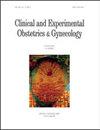Impact of Urinary Incontinence on Women’s Sexuality
IF 0.6
4区 医学
Q4 OBSTETRICS & GYNECOLOGY
引用次数: 4
Abstract
Objective: Globally, the prevalence of urinary incontinence (UI) in women is estimated to be in the range of 25% to 45%. Different types of UI exist, being the most frequent ones stress UI, urgency UI and mixed UI. Being affected by UI is associated with a higher risk of sexual inactivity, regardless of its type. Mechanism: It is estimated that 5–38% patients with UI are sexually inactive due to UI, whereas 25–38% sexually active women would restrict their sexual activity due to UI. The prevalence of sexual dysfunction within sexually active women with UI is 23–56%. Findings in brief: In patients with UI, the most frequent sexual dysfunctions are dyspareunia (44%), female sexual interest/arousal disorder (34%) and orgasmic disorder (11%). Therefore, UI has a negative impact on the sexual function of sexually active women with UI. Coital incontinence is defined as the complaint of involuntary loss of urine during or after intercourse. UI with penetration represents any complaint of involuntary loss of urine with vaginal stimulation (either with a sexual toy, manually or with penetration). Orgasmic UI refers to any complaint of involuntary loss of urine occurring at orgasm, regardless of the sexual behaviour that has triggered it. Due to the high prevalence of coital UI (50–60%) in the female population and its strongly negative impact on women’s sexuality, patients should be specifically asked for coital UI in the gynecologic visits. Conclusions: UI affects between one in four and one in two women and had a negative impact on quality of life. Not only UI has an impact on female sexuality, but also different treatments which are offered to treat it can play a role. The reduction of sexual problems with pelvic floor muscle training in women with stress UI has been proved, being the rate of sexual activity doubled. A significant improvement of the overactive bladder associated to urgency UI and female sexual function has been described after the pharmacological treatment or botulinum toxin. Finally, significant improvement of the sexual function has also been found after midurethral slings for stress UI, as well as for coital UI.尿失禁对女性性行为的影响
目的:在全球范围内,女性尿失禁(UI)的患病率估计在25%至45%之间。存在不同类型的UI,其中最常见的有压力UI、紧急UI和混合UI。无论其类型如何,受UI影响都会导致更高的性不活跃风险。机制:据估计,5-38%的UI患者因UI而性不活跃,而25-38%的性活跃女性会因UI而限制性活动。性活跃的UI女性性功能障碍的患病率为23-56%。简言之:在UI患者中,最常见的性功能障碍是性交困难(44%)、女性性兴趣/性唤起障碍(34%)和性高潮障碍(11%)。因此,UI对性活跃的UI女性的性功能有负面影响。性交失禁是指在性交过程中或性交后出现的非自愿尿失禁。渗透性UI表示阴道刺激(用性玩具、手动或渗透)导致的非自愿尿液丢失。性高潮UI是指在性高潮时发生的任何非自愿尿液丢失的投诉,无论引发性高潮的性行为是什么。由于性交UI在女性人群中的高患病率(50-60%)及其对女性性行为的强烈负面影响,应在妇科就诊时特别要求患者进行性交UI。结论:UI影响四分之一至二分之一的女性,并对生活质量产生负面影响。UI不仅对女性性行为有影响,而且提供的不同治疗方法也可以发挥作用。事实证明,在有压力UI的女性中,盆底肌肉训练可以减少性问题,因为性活动的比率翻了一番。药物治疗或肉毒杆菌毒素治疗后,与尿急UI和女性性功能相关的膀胱过度活动有显著改善。最后,在中尿道悬吊术治疗应力性UI和性交性UI后,性功能也得到了显著改善。
本文章由计算机程序翻译,如有差异,请以英文原文为准。
求助全文
约1分钟内获得全文
求助全文
来源期刊
CiteScore
0.50
自引率
0.00%
发文量
241
审稿时长
1 months
期刊介绍:
CEOG is an international, peer-reviewed, open access journal. CEOG covers all aspects of Obstetrics and Gynecology, including obstetrics, prenatal diagnosis, maternal-fetal medicine, perinatology, general gynecology, gynecologic oncology, uro-gynecology, reproductive medicine, infertility, reproductive endocrinology, sexual medicine. All submissions of cutting-edge advances of medical research in the area of women''s health worldwide are encouraged.

 求助内容:
求助内容: 应助结果提醒方式:
应助结果提醒方式:


